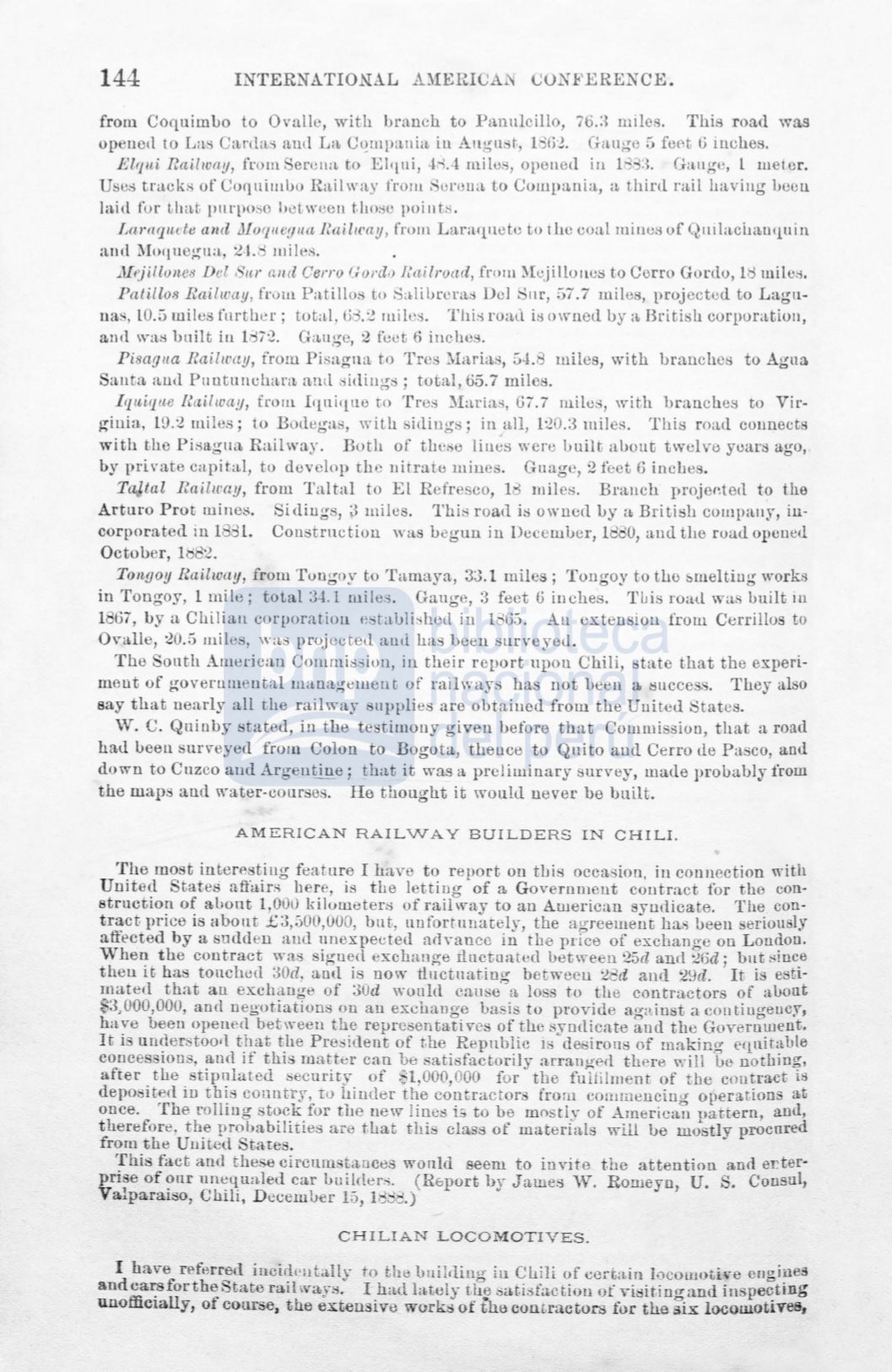

144
INTERNA.TIO.N:á.L
A.MERWA~
UUNFERENCE.
from Coquirnbo to Ovalle, witll branch to Panulcillo,
76.:~
miles.
Tllis road was
opeuetl toLa · Canlas aml La
C~m[HLni<t
iu A11•rnst,
1:3fi·~.
Gaug-e 5 feet
ti
iuches.
Elr¡ui Rai/way,
from 'erena to Eltpti,
-1-l..t
miles, opened in
B~M. G~tuge,
l
meter.
UsU<> tracks of Coc¡nillluo Railway t'rom Seroua to Cowpauia,
<t
thiru rail having Lecu
laid fur Llmt pnrpO'>O l•úL wcen t.lwse points .
f-antqltl:te antl
J.Iuqueg1ut
Rail11•ay,
from Laraflt!Ote to
T
he coalmiue1:1 of QntlacÍJ<tml
u
in
and
Mottucgua,
;¿.t, :;
llliles.
~ft>jillune8
Del Sur
antl
Cerro Ooi'Cl,¡ J:cúlrotul,
from
~Iejilloncs
to Cerro Gordo,
1:::!
miles.
Palillo.~
Railway,
frutn Patillo:l to
Saliurera:~
Del Sttr, 57.7 miles, proj ectcd to Lagu–
nas, 10.5 miles fnrthér; total,{)
.:.!
ruiles.
Thi::;roaü
it~owned
by'" British corporation,
atHl was built in
1c:1n.
Gange, 2 feet 6 inchcs.
Pisagua
RaillL'lt!J,
from Pisagna to Tres .:\larias, 54.8 miles, with Lranchet.l to Agua
San a auü
Puutuncl.mmantl ·i1liugs; total, 65.7 miles.
IrJlÚI.J.Ile
lútilway,
from
Ir¡ui(ple
to Tres
~Iarias,
G7.7
mile' ,
with branches to Vir–
ginia,
W.:2
miles; to Bouegas, witl.t sidiugs; in all,
120.3
miles.
'l'l.tis roau counects
with tbe Pisagua Railway. Both of
the~;e
liues were built auout twelve yoars ago,
by printte C<tpital, to dovclop thc nitrato mines. Guage, 2 fcet 6 iuches.
Taltal Rail1cay,
from T altal to El Refresco, 1 mile::;. Branch projer.tell to the
Arturo Prot mi11e1:1.
Si<liugs,
;~miles.
This roa<l is O\Yncü Ly
:1
British compa11y, in–
cor porated in
188 t.
Constrnctiou was begun in DecemlJer, ltloO,
a.udthe roau opeueu
October,
1/:í
'2.
Tongoy
Railway,
from Tougoy to Tamaya,
33.1
miles; Tongoy to tho &meltiug works
in Tougoy,
1
mi le; total
34.1
miles. Gauge,
:3
fect
ti
in ches. Tuis roaü was built in
1867, by a Chilian corporatiou estaLli:;hed iu ld65. Au extensiou from Cerrillos to
Ov;~,lle,
:20.5
miles, was projecteü anü has bcen surveyeú.
Tho Sonth American
Commit~sion,
in their rcport upou Chili, ¡;tate that tbe e:s:peri–
meut of goverumeutal managemeut of rail,\·ays has not beeu a ¡,;ucces. . They also
say that nearly all the railway supplies are obtaiued frorn tlle Uuited !:::\tates.
\V.
C. Qniuby r:!tateu, in the t e ·timony giveu before that Commission, tltat a roau
hau been surveyed from Colon to Bogota, theuce to Quito aud Cerro de Paseo, anu
down to Cuzco and Argeutine; that it was a prcliwinary survey, made probably from
the maps aud water-eourses. He thought it woulu never be built.
AMERICAN RAILWAY BUILDERS IN CHILI.
The most
in~erfl
tiug feature I havo to report on tl.Jis occasion, in counection with
U uited States afl'airs here, is
tite letting of a Governmout contmct for tho con–
st ruction of auont
1,0ulJ
kilurneters of rail way to an American yudicate.
'l
he con–
t ract price is about l:3,:JOO,UOO, hut, unfortunately, the agreement ha:o; beeu seriou ly
afi'ected by a sudden auu unexpeetell arlyanco in tbe price of exchanrre on Loudon.
When the contract was sigued exchange rlnctuated betweeu :25d awl
~f:id;
b11t since
theu
it
has tonche<l
30d.
and is now tluctuat.ing betweeu
;¿ d
ancl
2Hd.
It
is e ti–
mated that au exchange of
;)Ud
wonltl cause a loss to the contractors of abont
$3,000,000,
ancl negotíations on au exebange ba. is tu proviue ag<•inst a CIHttingeucy,
ha ve been opene!l uetweeu the repros
entati.ves of tlle syndicate and thc Governwent.
It
i nnderstoo•l that the Pro ·ident of
t.heRepnblic
11:1
desirons of makincr etplitable
couce. iou ,
~ncl
if this matter can be
satisfactorily arrau¡.¡;e-rl thPre will
be
notbin~,
afrer the snpnlatcd
~ecurity
of
81,000,000
for the full il ment of the contract
1s
depositNl in tbis country, t o hintler the coutractors froru comrnenciu"' operat.ions at
once. The rolling ·tock for the new linus
i:,
to be mostl,\- of
America~1
pattern, and,
t herefore, the probabiliües ar that this class ot' rnaterials
will
be mostly procnred
frorn the Uuit,d
tates.
Thi fact ancl these circnrnst<laces wonld seem to invite the attention anrl m::ter–
prise of onr unequaleü car builcler-;.
(Róport
by
Jallles
,V.
Rollleyo, U.
. Consul,
Va.lparai::m, Chili, Dccemuer
15,
ld::l '.)
CHILlAN LOCOMOTIVES.
I have referred incirlt·
:lta.lh·to the builclin•r iu Cllili of cor t:tin
l0comoti•·e engines
andca~forthe ~tat
ra.il
way -:I had
lately
the <:>ati:;faction of
vit
~itiuga.ndin. pecting
n noffielally, of course, the ex tensivo works of the contractors for t
he six l<><:omotives,
















